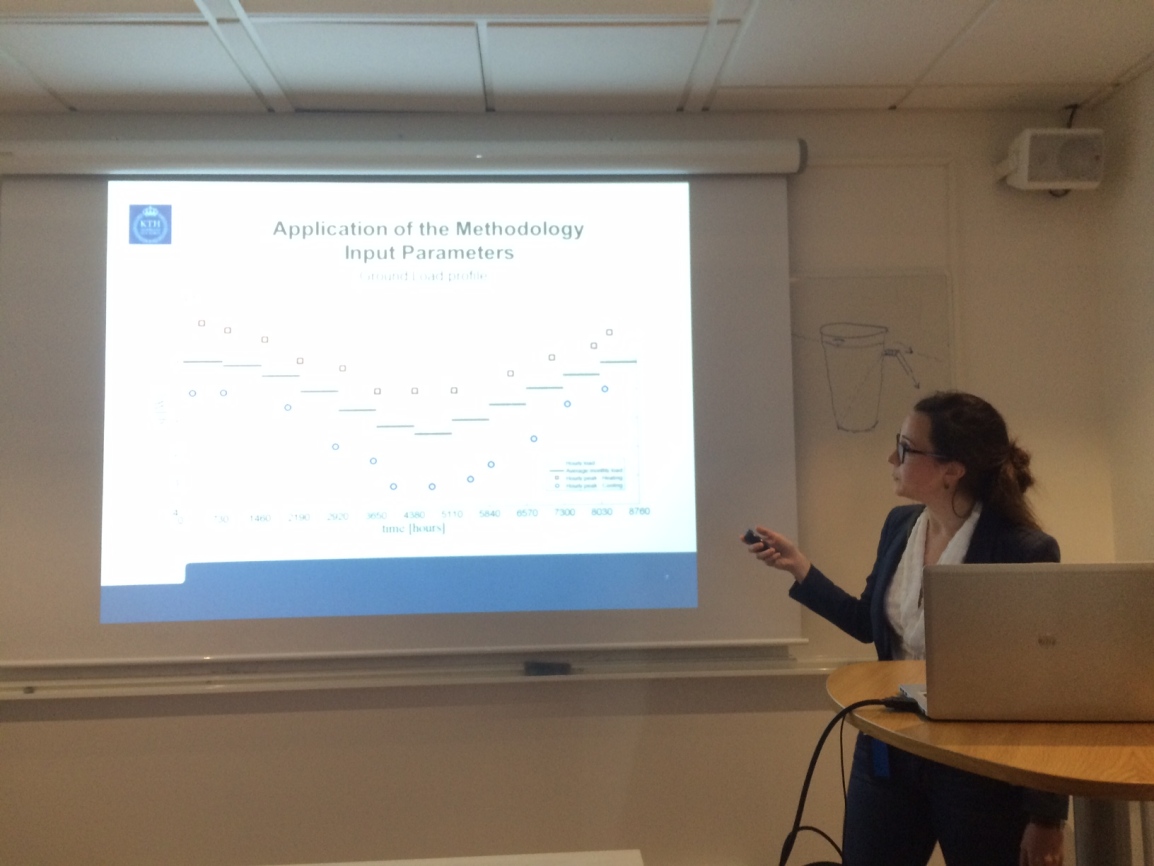GEO+SOL May 28th 2015
Almost 40 representatives from the ground source heat pump industry and academy visited KTH for an open seminar about ground source and solar systems. Prof. Bernier, the keynote speaker, talked about his experience with design of borehole heat exchangers and about the latest research carried out by his group at EPM. Information was also given about the Drake Land Solar Project, an installation that Prof. Bernier has been following up. Prof. Bernier. Bore field sizing: Theory and applications (pdf 6.7 MB)

The keynote talk was followed by five other presentations, four from KTH and one from NTNU/Asplan Viak in Norway.
Patricia Monzó, PhD student at KTH, gave a quick summary of her latest work carried out together with Prof Bernier at EPM and treating optimum borehole spacing. She modified the well-known ASHRAE method in order to minimize the total borehole length by changing the borehole spacing, considering the starting month of operation. See Patricias presentation here Patricia Monzó Optimum borehole spacing (pdf 522 kB)

Nelson Sommerfeldt, also PhD student at KTH, presented part of his work and the motivations for thermal storage in support of solar photovoltaics in Sweden, as well as the potential of one of the ideas proposed in the latest EFFSYS Expand call, the combination of ground source heat pump systems with solar thermal and solar photovoltaics. See Nelsons presentation here GeoSeminar-PVT+GSHP.pdf (pdf 924 kB)

José Acuña, researcher at KTH, presented a KTH project aiming at monitoring a new ground source installation with 130 boreholes at the University of Stockholm (project financed by the Swedish Energy Agency in collaboration with Tyréns, Skanska, Stures Brunnsborrningar och Akademiska Hus) and one American project in Albany Georgia, with 306 boreholes (ran by the company AH&P Engineers). At both sites, besides a full energy follow up at a system level, distributed temperature measurements are starting to be done in multiple boreholes for better understanding the heat transport processes in the ground, for system optimization and for validation of design models. More information about these two installations will come as KTH is closely involved in both projects. See José's presentation here Jose Acuna - DTS and BTES in Sweden and USA2.pdf (pdf 5.7 MB) See also this video
Peter Kjaerboe, also researcher at KTH, talked about his earlier experience on studying heat/cold from mines, tunnels and lakes (sources/sinks of energy). Some studies from Sweden and USA were presented, including measurements in the ground, city planning proposals and environmental issues. Such open systems have different challenges, similar to those in Aquifer thermal energy storages, which led to a discussion about one of the applications about open systems recently submitted at the second effsys expand call, intending to monitor, study and characterize aquifer systems. See Peter's material here Peter Kjaerboe.pdf (pdf 661 kB)
The last presentation was held by Henrik Holmberg, PhD student at NTNU and consultant at Asplan Viak, in Norway. Henrik talked about his work deep borehole heat exchangers (Henrik Holmberg, NTNU), with validated models showing that deep boreholes can have a good potential since that are more insensitive to thermal influence from neighboring systems, with required pumping power in the order of 1-2 % of the produced thermal energy. An application to study this further was also submitted to the EFFSYS expand program. See Henrik's presentation here Presentation Holmberg KTH.pdf (pdf 1.7 MB)
The whole group (also with representatives from a few other countries!) represented by consultants, researchers, drillers, contractors, building owners, pipe and component manufacturers, agreed on continuing a tradition of carrying out such open seminars! More info to come!!
